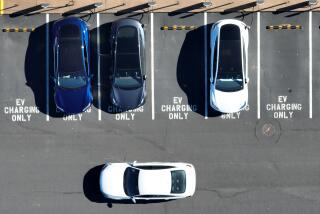Shift to Alternative-Fuel Cars Accelerates : Energy: The federal government is leading the way in buying vehicles that donât run on gasoline.
WASHINGTON â Facing serious air pollution, America is trying to wean its cars from gasoline. The transition toward a cleaner motor fuel wonât be quick, but there are signs that gasolineâs grip is loosening.
For example, President Bush marked the governmentâs purchase of hundreds of alternative fuel vehicles by taking a spin around the White House driveway last week in a van powered by compressed natural gas.
Auto makers are not only beginning to produce more such vehicles but also a limited number of cars, vans and small trucks that run on methanol. And within a few years, auto industry officials say, electric cars will come purring out of showrooms.
Alternative-fuel technology âis here today and itâs ready to roll,â said Claudia Baker, an executive of the energy commission in California, a state that has vigorously pushed substitute motor fuels to help ease its severe air pollution.
Some energy experts and environmentalists predict that more than 2.5 million vehicles powered by fuels other than gasoline will be on American roads by the end of the decade.
California will require as many as 40,000 electric-powered cars to be sold annually in the state by 1998 and five times that many by the year 2003. Other states, including New York, are on the verge of enacting similar requirements.
New federal clean air rules also call for 150,000 âclean fuelâ vehicles to be sold annually in California--and possibly other states--by 1996 and twice that many two years after that. In addition, federal law calls for phasing in alternative-fuel fleet vehicles in urban areas with the worst air pollution. At least six states already have incentives or requirements to shift operators of taxicabs, delivery trucks and other fleets away from gasoline or diesel.
In other signs of the future:
* In Jeffrey Seislerâs back yard outside Washington thereâs a âhome fueling applianceâ that uses the same natural gas that heats his home to refuel the car he uses each day to go to work.
* In Sacramento, a Shell service station, in a joint program with Pacific Gas & Electric, offers not only gasoline but also compressed natural gas. It is among 14 natural gas outlets opened by PG&E;, primarily for fleet-owned vehicles, in Northern California.
* As many as 2,000 methanol-powered Chevrolet Lumina sedans will be shipped for sale in California later this year. General Motors also says it plans to have an electric-powered passenger car in showrooms in about three years.
* The federal government this year will receive 3,125 vans and small trucks that run on compressed natural gas or methanol and will order 5,000 more next year. In five years, the government hopes that one of every two of the expected 70,000 vehicles it will buy annually will be non-gasoline powered.
Gasoline powered cars and trucks are the single largest source of air pollution, emitting smog-forming hydrocarbons and toxic chemicals as well as the principal âgreenhouseâ gas, carbon dioxide. Most alternative fuels produce significantly less pollution from vehicles, although in some cases their production may still have environmental drawbacks that contribute to global warming.
Generally, the widespread use of alternative-fuel vehicles also would sharply reduce Americaâs dependence on petroleum since two-thirds of the 17 million barrels of oil consumed each day goes to transportation.
âWhile (the gasoline-driven) vehicle once provided cheap, nearly unlimited mobility, today it is the cause of air pollution, potential climate instability and a nationwide addiction to ever greater oil imports,â says Deborah Gordon, an automotive fuels experts for the Union of Concerned Scientists, an environmental advocacy group.
Bill Sessa, a spokesman for the California Air Resources Board, predicted that âgasoline will be the dominant fuel of the future just as it has been in the past.â But he also said gasoline of the future is likely to be cleaner, and other fuels âwill have a niche in the market place.â
âThe long-term fuel market will be a market that offers more options than we see today,â said Norman Bryan, a vice president for Pacific Gas & Electric.






